Ingredients
For the wrap filling
-
4 homemade sourdough wholemeal flatbreads
-
3 large beetroots, different varieties/colours if possible (500g)
-
50g mint
-
30g dill
-
50g winter purslane or lettuce of choice
-
80g sunflower seed butter
-
2 tbsp lemon juice
-
2 tbsp dukkah
-
100g green or puy lentils
For the Zhough
-
50g coriander
-
10g mint
-
2 garlic cloves
-
2 green chillies
-
12 cardamom pods
-
1 tsp cumin seeds
-
3 tbsp lemon juice
-
4 tbsp extra virgin olive oil
Method
For the wholemeal sourdough flatbreads follow this recipe (or one you like), but instead of dividing them into six, split the dough into four and roll each piece out as thinly as you can. Then cook in a pan as instructed.
Preheat the oven to 200 degrees. Trim the beet greens, if they have any, and keep for later. Then place each individual beet on a separate sheet of kitchen foil, sprinkle with salt and drizzle with olive oil. Wrap the foil around the beet and roast them on a baking tray 60 minutes or until you can pierce them with a knife. Loosely open the foil parcels and let the beets cool off until cold enough to handle.
While the beets are roasting, cook the lentils as instructed on the packaging. Pick the mint and dill leaves and keep in a bowl of ice or cold water. This way they stay nice and fresh, packed with flavour. Mix the sunflower seed paste together with 2 tbsp of the lemon juice, a pinch of salt and around 4 tbsp of water. Keep adding water to loosen the paste until you can drizzle it from a spoon. In a frying pan, gently fry the beet greens with a drizzle of olive oil and a pinch of salt. When they are slightly wilted add a splash of water and let them cook in the residue steam until tender. Set aside for later.
To make the zhough, roughly chop the coriander including the stalks and pick the mint leaves. Peel and roughly chop the garlic. Trim and roughly chop the green chillies. Remove the seeds from the cardamom pods and quickly toast them together with the cumin seeds. Then grind both into a fine powder. Add the herbs, garlic, chillies, spices and 1/4 tsp salt to the bowl of a food processor or hand blender and pulse until finely chopped. Then stir in the lemon juice and olive oil. The lemon juice will discolour the zhough after a while, so only add to the amount you intend to eat the same day.
When the beets have cooled down enough, remove the skins by holding them with a paper towel, or wearing gloves, and sliding the skin off. Cut each beet into 4 wedges. Drain the picked herbs and mix them together in a bowl, ready to go on the wrap as needed.
Now it’s time to assemble. Drizzle some sunflower seed sauce over the flatbreads followed by a handful of herbs & lettuce, some cooked lentils, a few wedges of beet, a bit of the zhough, a squeeze of lemon juice and a sprinkle of dukkah. Roll them up and enjoy.

Beetroot Wraps with Zhough and Sunflower Seed Tahini
Ingredients
For the wrap filling
- 4 homemade sourdough wholemeal flatbreads
- 3 large beetroots, different varieties/colours if possible (500g)
- 50 g mint
- 30 g dill
- 50 g winter purslane or lettuce of choice
- 80 g sunflower seed butter
- 2 tbsp lemon juice
- 2 tbsp dukkah
- 100 g green or puy lentils
For the Zhough
- 50 g coriander
- 10 g mint
- 2 garlic cloves
- 2 green chillies
- 12 cardamom pods
- 1 tsp cumin seeds
- 3 tbsp lemon juice
- 4 tbsp extra virgin olive oil
Instructions
- For the wholemeal sourdough flatbreads follow this recipe (or one you like), but instead of dividing them into six, split the dough into four and roll each piece out as thinly as you can. Then cook in a pan as instructed.
- Pre-heat the oven to 200 degrees. Trim the beet greens, if they have any, and keep for later. Then place each individual beet on a separate sheet of kitchen foil, sprinkle with salt and drizzle with olive oil. Wrap the foil around the beet and roast them on a baking tray 60 minutes or until you can pierce them with a knife. Loosely open the foil parcels and let the beets cool off until cold enough to handle.
- While the beets are roasting, cook the lentils as instructed on the packaging. Pick the mint and dill leaves and keep in a bowl of ice or cold water. This way they stay nice and fresh, packed with flavour. Mix the sunflower seed paste together with 2 tbsp of the lemon juice, a pinch of salt and around 4 tbsp of water. Keep adding water to loosen the paste until you can drizzle it from a spoon. In a frying pan, gently fry the beet greens with a drizzle of olive oil and a pinch of salt. When they are slightly wilted add a splash of water and let them cook in the residue steam until tender. Set aside for later.
- To make the zhough, roughly chop the coriander including the stalks and pick the mint leaves. Peel and roughly chop the garlic. Trim and roughly chop the green chillies. Remove the seeds from the cardamom pods and quickly toast them together with the cumin seeds. Then grind both into a fine powder. Add the herbs, garlic, chillies, spices and 1/4 tsp salt to the bowl of a food processor or hand blender and pulse until finely chopped. Then stir in the lemon juice and olive oil. The lemon juice will discolour the zhough after a while, so only add to the amount you intend to eat the same day.
- When the beets have cooled down enough, remove the skins by holding them with a paper towel, or wearing gloves, and sliding the skin off. Cut each beet into 4 wedges. Drain the picked herbs and mix them together in a bowl, ready to go on the wrap as needed.
- Now it’s time to assemble. Drizzle some sunflower seed sauce over the flatbreads followed by a handful of herbs & lettuce, some cooked lentils, a few wedges of beet, a bit of the zhough, a squeeze of lemon juice and a sprinkle of dukkah. Roll them up and enjoy.
























0 Comments